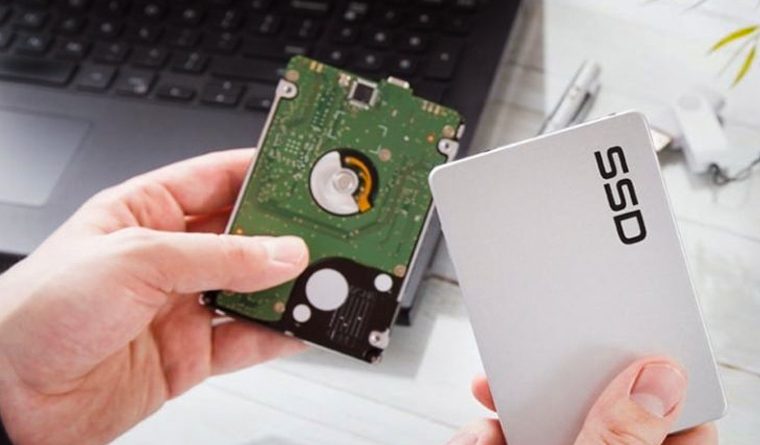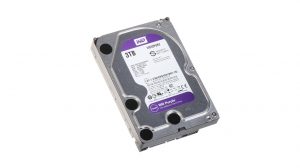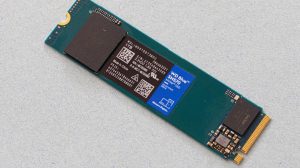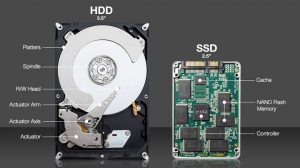
Choosing the appropriate storage is more than a matter of evaluating capacity and pricing. The type of storage used by your computer has an effect on its performance, including its power consumption and dependability. The two primary storage alternatives to consider are solid state drives (SSDs) and hard disc drives (HDDs). Here’s a quick overview to the optimal application of each and how to compare.
What Is an HDD?

A hard disc drive (HDD) is a data storage device that resides within a computer. It has rotating discs on which data is magnetically stored. The HDD is equipped with an arm equipped with multiple “heads” (transducers) that read and write data to and from the disc. It operates similarly to a turntable record player, which utilises an LP record (hard disc) and an arm with a needle (transducers). The arm slides the heads across the disk’s surface in order to access various types of data.
Hard disc drives (HDDs) are considered a legacy technology, which means they have been around longer than solid state drives (SSDs). They are generally less expensive and more practical for data that is not frequently accessible, such as backups of images, videos, or business information. They come in two popular sizes: 2.5 inch (often used in laptops) and 3.5 inch (desktop computers).
What Is a Solid State Drive (SSD)?

SSDs are called solid state drives (SSDs) because they are powered by solid state devices. All data is saved in integrated circuits on an SSD. This distinction from HDDs has a number of implications, most notably in terms of size and performance. Without the requirement for a spinning disc, SSDs can be as small as a stick of gum in shape and size (referred to as the M.2 form factor) or as small as a postage stamp in size. Their capacity — or the amount of data they can store — fluctuates, which makes them ideal for smaller devices such as compact laptops, convertibles, or 2 in 1s. Additionally, SSDs significantly cut access time by eliminating the need for users to wait for platter rotation to begin.
SSDs are more expensive per gigabyte (GB) or terabyte (TB) of storage than HDDs, although the gap is decreasing as SSD prices continue to fall faster than HDD pricing year over year.
Also check: How to Choose USB Hub?
SSD vs. HDD: Performance
SSDs are becoming an increasingly popular choice due to their speed. SSDs outperform HDDs across the board due to their electrical circuitry and lack of physical moving parts. This results in speedier startup times and fewer delays while opening apps or doing computationally intensive tasks. For instance, the Intel SSD D5-P5316 is a 15.36TB enterprise-grade SSD with a bandwidth of over 7000 MB/s. The 14TB Seagate Exos 2×14, a suitable hard drive, provides bandwidth of up to 500 MB/s. That is a 14-fold difference! 1
These quicker speeds result in performance improvements in a variety of areas, including when signing in and waiting for apps and services to start, as well as when doing storage-intensive tasks like copying a large file. Performance degrades substantially with an HDD, however an SSD can continue to work on other activities.
Speed is also affected by the interface that connects an SSD vs. HDD to the rest of the computer system when data is transferred back and forth. You may have heard of SATA and PCI Express interfaces (PCIe). SATA is a legacy technology that is slower and older, whereas PCIe is modern and faster. SSDs with PCIe interfaces are often much quicker than HDDs with SATA interfaces, as PCIe has additional data transfer channels. Consider the difference between the amount of cars that can pass on a one-lane country road and a four-lane freeway.
While nobody ever complains about their computer being too fast, there are instances when an HDD makes sense. If you need to store terabytes of data, HDDs remain the more affordable alternative, although this is changing as SSD prices continue to fall and newer NAND technologies enable better bit densities per NAND die. Consider data as either cold or hot when making computer storage decisions. “Cold” data may contain years’ worth of images you wish to store on your laptop but don’t look at on a daily basis or want immediate access to. For cold data, HDDs can be a great, cost-effective option. On the other hand, if you’re a firm that conducts real-time transactions, edits films and images, and requires rapid access to a database of files, video clips, or models, or even just runs the operating system, you’re dealing with “hot” data. SSDs’ high performance makes them an attractive choice when quick access to your data is critical.
SSD vs. HDD: Durability
The degree to which a NAND SSD is subjected to write wear is partially determined by the condition of data already on the drive, as data is written in pages but erased in blocks. When writing sequential data to a relatively new SSD, the data can be efficiently written to the drive’s subsequent free pages. While small blocks of data must be modified (for example, when amending documents or numerical values), the old data is read into memory, edited, and then re-written to a new disc page. The old page has been designated as invalid due to the presence of deprecated data. When no more free pages are available, those designated as “invalid” are released for use in a background operation known as “defragmentation” or “wear levelling.” All valid pages in a given block must first be transferred to other free locations on the drive, leaving only invalid, deprecated pages in the original block. The original block can then be deleted to make room for new data.
Internal NAND housekeeping activities such as wear levelling result in write amplification, in which the total number of internal SSD writes exceeds the number of writes required to simply deposit fresh data on the drive. Because each write destroys individual NAND cells significantly, write amplification is a major cause of wear. Built-in technologies assist NAND SSDs in equally dispersing wear over the drive. However, the main line is that write-intensive workloads (particularly random writes) cause NAND SSDs to wear out more quickly than other input/output (I/O) patterns due to increased write amplification.
The good news is that SSD disc durability is always specified in terms of worst-case random write patterns. For instance, when a drive supports one drive write per day, it indicates that you can write at least one full drive’s worth of data every day during the drive’s warranty period (typically 5 years).
Read More: Why Install an Additional Hard drive? Know Here!
SSD vs. HDD Head-to-Head

In terms of capacity, SSDs for computers range from 120GB to 30.72TB, whilst HDDs go from 250GB to 20TB. When cost per capacity is considered, HDDs win out, but as SSDs get more affordable, this will become less of a distinction for HDDs. However, SSDs perform far more work per server, requiring fewer devices to get the same output as an HDD. As a result? SSDs have a lower total cost of ownership (total cost of ownership).
Reliability is defined as the ability of data to be stored in its intended state, uncorrupted. SSDs are generally more dependable than HDDs, which is another benefit of their lack of moving parts. That is because SSDs are not affected by vibration or associated temperature issues when they are stationary.
SSDs often consume less power and provide longer battery life, as data access is significantly faster and the device is idle for a longer period of time. Due to their spinning platters, HDDs consume more energy during startup than SSDs.
SSDs Offer Significant Cost Savings Over Hard Disk Drives
SSDs perform substantially better than HDDs. Almost as well-known is SSDs’ reliability advantage. Due to these inherent advantages, SSDs do not require replication for performance and require significantly less replication for reliability. Additionally, faster SSD speed enables considerably more efficient data reduction methods than HDDs. The data reduction ratio is the ratio of the amount of host data stored to the amount of physical storage required; a 50% ratio is similar to a 2:1 data reduction ratio. Because data reduction enables the user to store more data than is physically possible on the physical hardware, the effective capacity of the system is raised. Compression and deduplication methods can significantly reduce the amount of raw storage required to meet a demand for “usable capacity.”
Modern methods are SSD-optimized, leveraging their performance to achieve a high data reduction ratio (DRR) while maintaining application speed. For example, Facebook’s Zstandard compression algorithm compresses and decompresses data far quicker than HDDs can read/write, enabling real-time application of the methods on SSDs. 2 Another example is VMware’s vSAN, which only supports compression and deduplication in all-flash setups.



